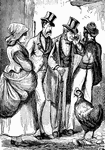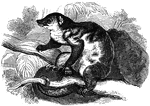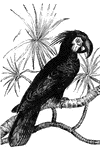
Cumberland Gap
"Cumberland Gap and Heights, Tenn., from the Kentucky side. Cumberland Gap was a place of such importance…
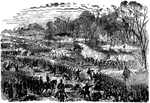
Battle of Champion Hills
"Battle of Champion Hills, May 16th, 1863- the formidable position of General Pemberton carried by Generals…

War in Mississippi
"The war in Mississippi. General McPherson's army crossing the Big Black at messenger's Ferry, Thursday,…

Dutch Gap Canal
"Blowing out of the bulkhead of the Dutch Gap Canal, James River, Va., January 1st, 1865. At twelve…
!["Siege of Petersburg. The [African American] infantry bringing in captured guns and cheers of the Ohio troops. When the [African American] troops found themselves within the works of the enemy no words could paint their delight. Numbers of them kissed the guns they had captured with extravagant satisfaction, and a feverish anxiety was minfested to get ahead and charge some more of the Confederate works. A number of the [African American] troops were wounded and a few killed in the first charge. A large crowd congregated, with looks of unutterable admiration, about Sergeant Richardson and Corporal Wobey, of the Twenty-second United States [African American] regiment, who had carried the colors of their regiment and been the first men in the works. Our artist gives a sketch of this gallant action."— Frank Leslie, 1896](https://etc.usf.edu/clipart/11800/11801/petersburg_11801_mth.gif)
Siege of Petersburg
"Siege of Petersburg. The [African American] infantry bringing in captured guns and cheers of the Ohio…
!["Assault of the Second Louisiana [African American] Regiment on the Confederate works at Fort Hudson, May 27th, 1863. The Battle of Fort Hudson was a severe and well-fought action. The Federal troops displayed their usual bravery, and were well handled by General Banks, driving the enemy to his second line of works. Of the [African American] regiments General Banks, in his official report, says: 'They answered every expectation. Their conduct was heroic. No troops could be more determined or more daring. They made during the day three charges upon the batteries of the enemy, suffering very heavy losses, and holding their position at nightfall with the other troops on the right of our line. The highest commendation is bestowed upon them by all officers in command on the right. Whatever doubt may have existed heretofore as to the efficiency of organizations of this character, the history of this day proves conclusively to those who were in a condition to observe the conduct of these regiments that the Government will find in this class of troops effective supporters and defenders. The severe test to which they were subjected, and the determined manner with which they encountered the enemy leave upon my mind no doubt of their ultimate success. They require only good officers, commands of limited numbers, and careful discipline to make them excellent soldiers.'"— Frank Leslie, 1896](https://etc.usf.edu/clipart/11800/11805/ft-hudson_11805_mth.gif)
Fort Hudson
"Assault of the Second Louisiana [African American] Regiment on the Confederate works at Fort Hudson,…
!["Siege of Petersburg- the Ninth Corps charging on the enemy's works after the explosion of the mine, July 30th, 1864. Immediately after the explosion of the mine a hundred cannons opened along the Federal front, and at half-past five the Ninth Corps charged, carrying the fort with a part of the line on each side. The Second Division, which was in the centre, advanced and carried the second line a short distance beyond the fort, and rested, holding ground with the utmost determination. It was at the time the [African American] Division, under General White, was pushed forward and ordered to charge and carry the crest of the hill, which would have decided the contest. The troops advanced in good order as far as the first line, where they received a galling fire, which checked them, and although quite a number kept on advancing, the greater number seemed to become utterly demoralized, part taking refuge in the fort, and the remainder running to the rear as fast as possible. They were rallied and again pushed forward, but without success, the greater part of the officers being killed or wounded."— Frank Leslie, 1896](https://etc.usf.edu/clipart/11800/11856/petersburg_11856_mth.gif)
Siege of Petersburg
"Siege of Petersburg- the Ninth Corps charging on the enemy's works after the explosion of the mine,…
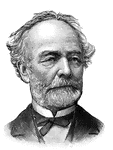
General Joseph E. Johnston
"General Johnston, born in Cherry Grove, near Farmville, Va., February 3rd, 1807; died at Washington,…
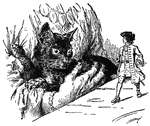
Gulliver and Giant Cat
Gulliver on a dinning table, with the giants of Brobdingnag, looking at a very large cat.

Grove of black-locust trees
A grove of black-locust trees. Contrast with the brush in the background on an adjoining farm.
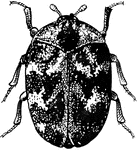
Adult Common Carpet Beetle
An adult common carpet beetle, a small grayish or black beetle belonging to the order Coleoptera.

Common Carpet Beetle Pupa
Pupa of the common carpet beetle, a small grayish or black beetle belonging to the order Coleoptera.

Common Carpet Beetle Larva
Larva of the common carpet beetle, a small grayish or black beetle belonging to the order Coleoptera.

Common Carpet Beetle Larva
Larva of the common carpet beetle, a small grayish or black beetle belonging to the order Coleoptera.

Fork-Tailed Kite
"The fork-tailed kite, (N. furcatus) is twenty-five inches long; the wings and tail black;…
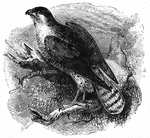
Goshawk
"The American goshawk &mdash the black-cap haw of Wilson &mdash A. atricapillus which has been…
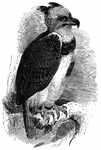
Harpy Eagle
Genus Harpyia, it is one of the largest, most fierce, and powerful eagles. It has a crest of…
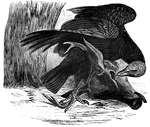
Black Vulture
Genus Coragyps, about the size of a small turkey. This one is feeding on a cow's head.

Black Vulture
Black vulture (or carrion crow), genus Coragyps, about the size of a small turkey. This group…

Black-Banded Dacelo
The black-banded dacelo, found around the Cape of Good Hope. They are known for feeding on earthworms,…
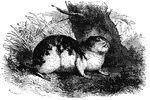
Lapland Lemming
"Of the Lemming genus, the Lapland Lemming is the most celebrated which is confined to Lapland and Norway.…
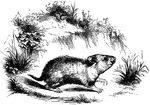
Hamster
It is a reddish-brown color above and black below, but variations in color ar enot uncommon. The length…

Sminthus Loriger
"Two and a half inches long, with a tail of nearly equal length. It is of a grayish-brown, with a black…
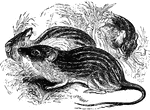
Barbary Mouse
"It is of a grayish-fawn color, with ten longitudinal brown strips along the back. Between the size…

Free Mouse
Dendromys Typicus. "Size of the common mice, and are of a pearly-gray color, and have a black band running…

Pithecheirus Melanurus
"This includes one animal, the P. melanurus, which has puzzled the naturalists, inasmuch as…
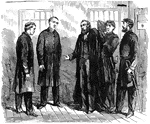
Execution Preparations
"Preparing the prisoner for execution- putting on the black robe."— Frank Leslie, 1896
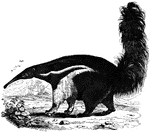
Tamanior
Inhabits most part of South America. About four feet in length. Spends the greater parts of its life…
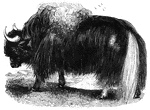
Yak
"The color of this animal in the wild and take, is black; the back and tail often white; the hair is…
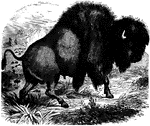
American Bison
"The head is very large and carried low; the eyes are small, black, and piercing; the horns are short,…
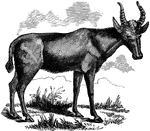
Bubula
"Is of a reddish-fawn color, with black horns, shaped like the tines of a fork. "— S. G. Goodrich,…
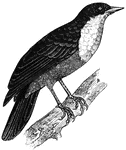
Bloody Pavao
The bloody pavao (coracina scutata) is a mostly black bird, which gets its name from the blood…
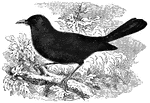
Blackbird
Black with a yellow bill, the blackbird feeds mostly on larvae, snails, worms, insects, and fruits.
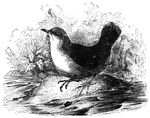
Black Dipper
The black dipper, also known as the European water-ousel, feeds on small shellfish and insects.

Blauw-Boc
"Is six feet long, three feet seven inches high, has round horns curved backward, and is of a blu-ish…
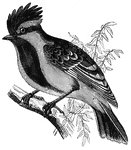
Black-Lored Tit
Native to the Himalaya Mountains, P. xanthogenys is somewhat smaller than the great tit.
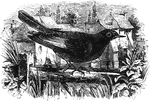
Black Redstart
A black redstart perched on a branch in front of a stone building. It greatly resembles the redstart.
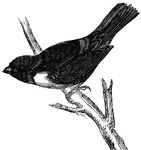
Scarlet Tanager
The scarlet tanager (also known as the black-winged summer redbird, or fire bird) feeds on insects,…
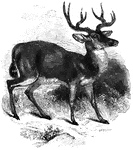
Mule Deer
"Is between the common deer and the American elk in size. Its horns are round and twice forked; the…

Black-billed cuckoo
Averaging about twelve and a half inches in length, the black-billed cuckoo resembles the yellow-billed…
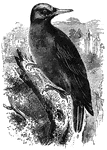
Great black Woodpecker
Chiefly making its habitat in Northern Europe, the great black woodpecker uses its long, sharp bill…
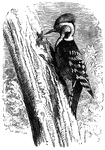
Middle Spotted Woodpecker
Found in Southern Europe, the middle spotted woodpecker has a black coat, with a crimson underside and…
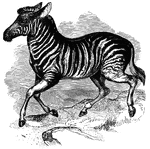
Dauw
"Is of a pale brown color; the underside of the body being whitish; head, body, and upper part of the…
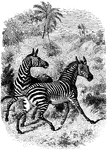
Zebras
"The ground color is white, or yellowish white, but the head, body, and legs to the hoofs are regularly…
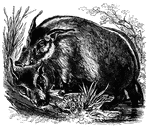
Guinea Hog
"It is of the size of a common hog; has long, narrow, straight ears, with a pencil of hair at the tips.…

Beluga Whale
"When young it is black, when mature white, sometimes having a yellowish or rosy tinge. It is twelve…

Porpoise
"This is from four to eight feet long, and nearly of a black color above, beneath whitish." —…

Manatee
"It is of a gray-black color, nine or ten feet long, and has vestiges of nails on the edges of the flippers,…
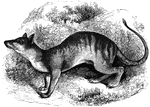
Tasmanian Wolf
"It is the size of a small wolf, with short, smooth, hair of dusky yellowish-brown color, barred on…

Banded Ant Eater
"It is about ten inches long, of a tawny color, marked with transverse bands of black and white. The…
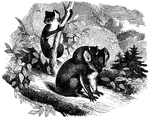
Koala
"Large as a moderate sized dog. It has long, thick and rather course fur, of an ashy-gray color; its…
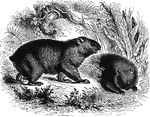
Wombat
"A short-legged, thickset animal, the body two feet long, the tail half an inch long. It lives in burrows…
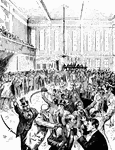
Black Friday
"The New York Gold Room on 'Black Friday,' September 24, 1869."—E. Benjamin Andrews 1895
!["The broad-billed sandpiper.. [is] six and a half inches long, variegated above with black, rufous, and gray; beneath grayish-white, tinged with buffish-red; rare, but distributed throughout Europe." — Goodrich, 1859](https://etc.usf.edu/clipart/13000/13073/bblldsndpipr_13073_mth.gif)
Broad-Billed Sandpiper
"The broad-billed sandpiper.. [is] six and a half inches long, variegated above with black, rufous,…
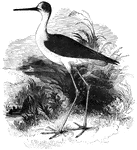
Black-Winged Stilt
Also known as the European stilt, the black-winged stilt inhabits coastal areas where it forages for…
